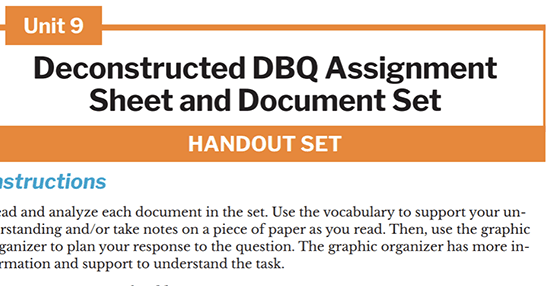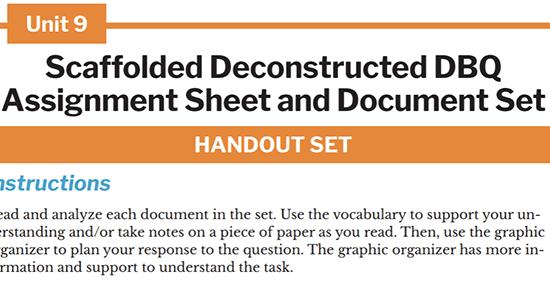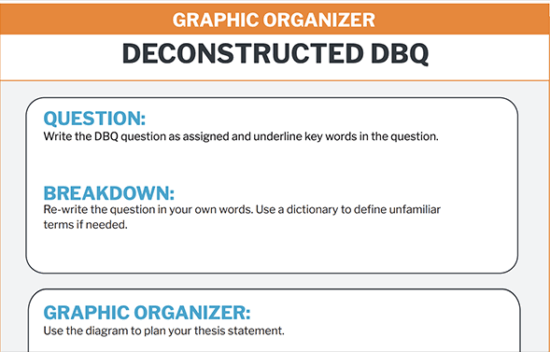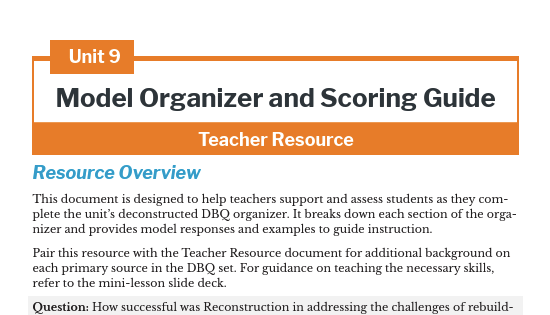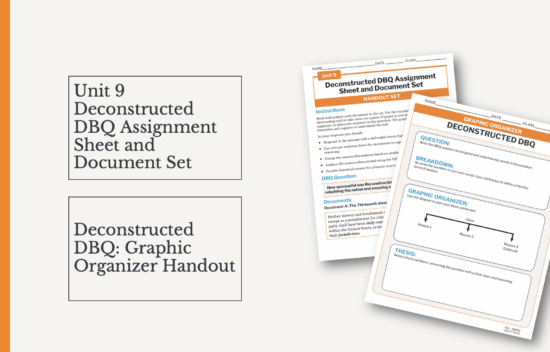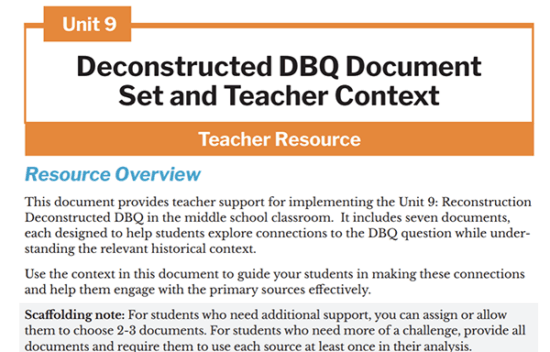
Unit 9: Reconstruction Deconstructed DBQ
Lesson Components
Guiding Question
- How successful was Reconstruction in addressing the challenges of rebuilding the nation and ensuring equal rights for African Americans?
Objectives
- Students will provide evidence drawn from primary sources to support a specific thesis.
- Students will provide historical context for primary source documents.
- Students will engage in critical thinking to interpret historical perspectives using VIEW (Voice, Intent, Environment, Who).
- Students will develop a thesis statement using historical evidence.
- Students will group sources based on similarities and historical themes.
Materials
Student Materials
- Document Set (choose 1)
- Deconstructed DBQ Assignment Sheet and Document Set Handout Set
- Scaffolded Deconstructed DBQ Assignment Sheet and Document Set Handout Set
- Documents contained within both sets include:
- Document A: The Thirteenth Amendment, Section 1 (1865)
- Document B: The Fourteenth Amendment, Section 1 (1868)
- Document C: The Fifteenth Amendment, Section 1 (1870)
- Document D: The Freedmen’s Bureau! political poster (1866)
- Document E: Classrooms for Black Children illustration (1866)
- Document F: President Andrew Johnson’s Veto Message of the Civil Rights Act (1866)
- Document G: Uncle Sam’s Thanksgiving Dinner illustration by Thomas Nast (1869)
- Documents contained within both sets include:
- Deconstructed DBQ Graphic Organizer
Teacher Materials
- Unit 9 Slide Deck
- Unit 9 Model Organizer and Scoring Guide Teacher Resource
- Unit 9 Deconstructed DBQ Document Set and Teacher Context Teacher Resource
Teacher note: There are two versions of the deconstructed DBQ documents. The original version includes light scaffolding and is intended for assessment. The second version is more scaffolded and is intended for using the deconstructed DBQ as a learning activity. The two versions can also be used for different levels of learners in the same class.
Facilitation Notes
- This mini-lesson reinforces all skills:
- Creating a thesis (Unit 1)
- Grouping primary sources (Unit 2)
- Document summary and analysis – VIEW (Unit 3)
- Adding historical context (Unit 5)
- Using/providing evidence (Unit 7)
- This mini-lesson, intended to take 45-60 minutes, builds background knowledge and reviews the skills needed for successful completion of the Deconstructed DBQ. It was created to accompany the mini-lesson teacher slide deck.
- This lesson was created to build upon the previous Deconstructed DBQ lessons. However, it can be implemented in isolation with additional supports. Modify the lesson by using the scaffolding notes to fit your classroom.
Anticipate (Optional)
Deconstructed DBQ Skill Video Intro
- Assign, or watch as a whole group, the supplementary Deconstructed DBQ skill video for the unit.
- The video will introduce a new primary source from the time period, give historical context and analysis, and then lead students through using the source to answer the Deconstructed DBQ question with a thesis statement.
- Pause the video at the processing questions embedded in the video to prompt reflection and discussion.
Teacher Note: The Deconstructed DBQ videos work as a pre-teaching tool but can also be used as a scaffolding support later in the mini-lesson. The video is based on a source not included in the Deconstructed DBQ document set, so that the video can be used as a resource in classrooms using the DBQ for skills building, assessment, or both.
Engage
Introduce the Deconstructed DBQ
- Refer to the DBQ question posted on a slide or the board. Tell students: “Today we will investigate how successful Reconstruction was in addressing the challenges of rebuilding the nation and ensuring equal rights for African Americans.”
Document Reading and Annotation
- Distribute the primary source set.
- Allow students 10-15 minutes to read, annotate independently and then ask any questions they may have.
Scaffolding note: There are 7 documents in this primary source set. Scale the set to fit the need of your students if needed. 3-4 documents is a good place to start.
Teacher note: There are slides in the teacher deck to facilitate a whole-group discussion or reading if your students need more support. There is historical context and more teacher assistance in the DBQ teacher resource document.
Explore
Give One, Get One, Move On
- Transition: Distribute lined paper to each student.
- Review the DBQ question with the class and clarify expectations for a thesis (claim and reasoning).
Step 1: Prep Your Ideas
- Provide students with 5-10 minutes to write three different thesis statements in response to the DBQ question.
- Encourage students to use their document analysis and prior knowledge.
- Emphasize that each thesis must:
- Answer the DBQ question.
- Include a claim and reasoning.
- Be clear and defensible.
Step 2: Let’s Move!
- Instruct students to stand up and find a partner.
- With each partner, students:
- Give one of their thesis ideas (read or summarize).
- Get one idea from their partner (thesis, claim, or reasoning).
- Write down the new idea they got from their partner.
- Say “thank you” and move on to a new person.
- Continue for 2-3 partner rotations.
Step 3: Add New Ideas
- Students return to their seats.
- Using ideas they gathered, they write two new or improved thesis statements.
- Encourage students to combine strong parts of previous ideas or try new reasoning.
Step 4: Go Again!
- Students repeat the activity:
- Give one revised thesis.
- Get one from a partner.
- Record the new idea.
- Move on to a new classmate.
- Continue for 2-3 partner rotations.
- By the end, students should have at least 5-6 thoughtful thesis statements to choose from for their Deconstructed DBQ.
Wrap-Up (Optional)
- Ask for volunteers to share one thesis statement aloud.
- Or have students star their strongest thesis and turn in their sheet as a formative check.
Teacher notes:
- Slides are included in the Teacher Slide Deck to lead students step-by-step through completing the Give one, get one, move on activity.
- Consider modeling a “Give One, Get One” exchange before starting.
- Circulate to listen for common misunderstandings or creative thesis phrasing.
- Use music to signal when to rotate, or set a visual timer.
Deconstructed DBQ Graphic Organizer:
- Transition: Distribute the Graphic Organizer, if not already distributed.
- Instruct students to fill in the organizer by:
- Writing the DBQ question and underlining key words
- Breaking down the question by defining unfamiliar terms and re-writing the question in their own words
- Diagraming a strong thesis statement with claim and supporting details/ reasons
- A written thesis statement (perhaps from the Give one, get one, move on activity.)
- At least 4 selected sources from the DBQ Document set grouped into categories that support the thesis
- Conduct a “VIEW” document analysis for each of the chosen documents
- Provide evidence to connect each document back to the thesis statement and add historical context to the argument
- Slides are included in the Teacher Slide Deck to lead students step-by-step through completing the Deconstructed DBQ Organizer.
Scaffolding note: Students needing more challenge could be given the opportunity to turn their Deconstructed DBQ into a written response at this stage. This could be a paragraph, or multiple paragraph essay depending on the amount of challenge needed.
Assess
- Students complete their graphic organizer and submit for assessment.
- Collect organizers to assess whether students:
- Provided adequate evidence to support their claims.
- Provided context surrounding several documents.
- Accurately analyzed sources using VIEW.
- Grouped sources based on logical connections.
- Created a clear, defensible thesis.
Teacher note: A model organizer and rubric are available to assist in assessing student work. You an also use generative AI to help provide individualized feedback for students with prompts like:
- “Evaluate this student response for clarity, evidence use, and historical accuracy. Highlight strengths and areas for improvement.”
- “Does the student’s thesis address the prompt fully and demonstrate understanding of Reconstruction?”
- “Did the student apply the VIEW method (Voice, Intent, Environment, Who) effectively in their analysis of each document?”
Reflect
Peer Review
- Have students share their organizer with a partner.
- Using the prompts from the slide deck, ask students to review their partner’s organizer.
- Ask students to focus on three aspects of the matrix on the slide.
Scaffolding note: The peer review could be completed before students submit their graphic organizers for assessment for a formative assessment.
